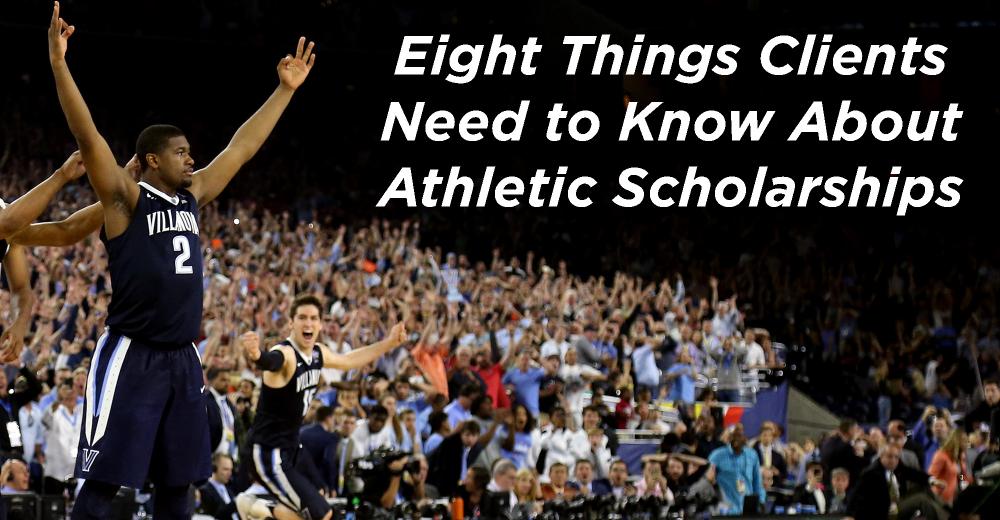1 9
Just 2 percent of high school athletes receive a sports scholarship at a National Collegiate Athletic Association (NCAA) school.
In reality, athletic scholarships are typically not as generous as regular financial aid or merit scholarships that student athletes can receive. What many families realize too late is that teenage athletes should not sacrifice their studies as they pursue what they hope will be a big sports payoff.
According to NCAA statistics, 56 percent of athletes competing in the organization’s Division I, which includes the nation’s largest brand-name sports programs, receive sports scholarships. Sixty-one percent of athletes in Division II, which is composed of many lesser-known schools, receive athletic scholarships, but these are routinely smaller.
There are just six sports in Division I where students, who do receive sports scholarships, always get a full ride. A full-ride scholarship in the NCAA system covers tuition and fees, room/board and required course-related books.
These are the six sports—also called headcount sports—and the number of scholarships permitted for each school:
Men’s Sports Number of scholarships
Football 85
Basketball 13
Women’s Sports Number of Scholarships
Basketball 15
Tennis 8
Gymnastics 12
Volleyball 12
Athletes who compete on a headcount team get either a full-ride scholarship or no athletic award at all. For instance, if there are 10 athletes on a school’s women’s tennis team, two of them won’t receive an athletic scholarship.
All other Division I teams are characterized as equivalency sports. The NCAA dictates how many scholarships that teams in a particular sport can offer, but full rides are not mandatory. In fact, coaches will often split up a scholarship and give it to multiple athletes. Consequently, a student could get a scholarship so small that it might just cover the cost of a semester’s books.
In Division I baseball, for example, a maximum of 11.7 scholarships exist. To attract more students, a baseball coach might divide them up so that more students would receive something. If a hot prospect got a full ride, there would be less available for his teammates.
Here are examples of the maximum scholarships allowed for some of the equivalency sports:
Men’s Sports Number of Scholarships
Golf 4.5
Ice Hockey 18
Lacrosse 12.6
Swimming 9.9
Track and Field 12.6
Water Polo 4.5
Women’s Sports Number of Scholarships
Softball 12
Track and Field 18
Gymnastics 12
Ice Hockey 18
Lacrosse 12
Swimming/Diving 8.1
It’s important to keep in mind that many schools do not fully fund their athletic scholarships so there can be less money available than what the NCAA allows.
An alternative to the NCAA sports programs is the National Association of Intercollegiate Athletics. Close to 300 colleges and universities, which are mostly smaller private institutions, participate in the NAIA. Here is a list of NAIA schools.
Sports scholarships are also possible at the community college and junior college level. You can learn more by visiting the website of the National Junior College Athletic Association.
For those who aren’t discouraged by the realities of athletic scholarships, there are smart ways for students to boost their chances of receiving athletic dollars.
Teenagers should make sure to compete at events that coaches attend. Sports combines and showcases have grown in popularity in recent years and coaches are taking advantage of them as a way to see many prospects.
Coaches also like these events because it allows them to see high-caliber athletes competing against each other. That will be much more illuminating than watching a talented athlete compete against a mediocre team.
Teenagers, however, shouldn’t assume that they will automatically be discovered at one of these events. Athletes need to let coaches know that they will be there, introduce themselves during the event, and follow up with the coach afterward.
Coaches typically use online recruiting services to look for prospects. Since most college programs don’t have large enough recruiting budgets, coaches use these online athletic databases for a portion of their scouting.
Teenagers can post their athletic profiles for free. Parents can pay if they want additional services such as recruiting videos or consulting with recruiting experts.
Two large recruiting services are Next College Student Athlete (NCSA) and BeRecruited; there are many other regional and smaller operations.
Division III schools are a source of college money even though they don’t award athletic scholarships. These schools offer financial aid and most award merit scholarships too. Division III encompasses 444 schools including some of the nation’s most elite institutions such as the University of Chicago, Washington University in St. Louis, Williams College and Pomona College. The Ivy League schools are in Division I, but they don’t provide athletic scholarships either.
Families should use ScholarshipStats.com, a wonderful source for athletic scholarship statistics, to research athletic prospects in specific sports, as well as at individual schools.

